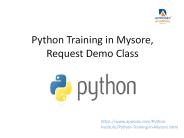Python MiniCourse - PowerPoint PPT Presentation
Title:
Python MiniCourse
Description:
Describe the characteristics of the list data structure in Python ... 'Alton', 'Darrel', 'Jen'] print roster. roster[1:3] = ['Sam', 'Kerri'] print roster ... – PowerPoint PPT presentation
Number of Views:83
Avg rating:3.0/5.0
Title: Python MiniCourse
1
Day 4 Lesson 14Lists
- Python Mini-Course
- University of Oklahoma
- Department of Psychology
2
Lesson objectives
- Describe the characteristics of the list data
structure in Python - Perform basic operations with lists including
creation, concatenation, repetition, slicing, and
traversing - Use string methods that require lists (join,
split) - Use lists in functions
3
The list data structure
- In Python, a list is a mutable sequence of values
- Each value in the list is an element or item
- Elements can be any Python data type
- Lists can mix data types
- Elements can be nested lists
4
Creating lists
- numbers 1, 2, 3, 4
- print numbers
- cheeses 'swiss', 'cheddar',
- 'ricotta', 'gouda'
- print cheeses
5
Creating lists
- mixed 1, 'a', 3.45
- print mixed
- single 'z'
- print single, type(single)
- empty
- print empty
6
Repeating a list
- Use the operator
- meat 'spam'4
- print meat
- print 1, 2, 33
7
List indexing
- Elements within a list are indexed (see Lesson
10) - print cheeses0
- Lists are mutable
- cheeses0 'Feta'
- print cheeses
8
Slicing a list
- Like strings and other sequences, lists can be
sliced - print cheeses14
- print cheeses2
- print cheeses2
9
Changing a slice
- roster 'Meghan', 'Tricia', 'Juan',
- 'Alton', 'Darrel', 'Jen'
- print roster
- roster13 'Sam', 'Kerri'
- print roster
- roster35 'Tayla'
- print roster
10
Inserting elements
- Slice notation
- roster22 'Dana', 'Ryan'
- print roster
11
Deleting elements
- Set slice to empty list
- roster35
- print roster
- The del keyword
- del roster23
- print roster
12
The insert and append methods
- The insert method
- roster.insert(2,'Jakob')
- print roster
- The append method
- roster.append('Tonya')
- print roster
13
The extend method
- Adds a list to the end of an existing list
- adds 'Ian', 'Stacie'
- roster.extend(adds)
- print roster
14
Extending a list
- Can also use operator
- roster 'Anya'
- print roster
15
Using the operator
- a 1, 2, 3
- b 4, 5, 6
- c a b
- print a, b, c
- The operator returns a new list that is a
concatenation of two lists
16
Note on list operations
- Be careful when using the operator and append
method - Try this
- d c 7
- Or this
- c.append(b)
- print c
17
List assignment and aliasing
- a 1, 2, 3, 4
- b a
- c a
- a2 9
- print a, b, c
- The slice operator returns a copy of a list
18
Other list methods
- roster.sort()
- print roster
- roster.reverse()
- print roster
19
Other list methods
- print roster.index('Tonya')
- print roster.index('Tonya', 2, 5)
- print roster.count('Sam')
- roster.remove('Sam')
- print roster
20
The join string method
- Concatenates a sequence of strings into a single
string with sep inserted between each item. - Syntax sep.join(list)
21
The split string method
- Returns a list of words from a string using sep
as the delimiter string - Syntax sep.split(list)
22
Example join_split.py
- t 'pining', 'for', 'the', 'fjords'
- delimiter '_'
- s delimiter.join(t)
- print s
- u s.split(delimiter)
- print u
23
Example
- print ''.join(t)
- print ' '.join(t)
- print '\t'.join(t)
24
Traversing a list
- for index in range(len(roster))
- print rosterindex
- for student in roster
- print student
- for index, student in enumerate(roster)
- print index, student
25
Traversing a list
- What does this do?
- empty
- for x in empty
- print x
26
Nested lists
- nested 1,2,3,4,5,6,7,8,9
- print nested
- print nested0
- print nested01
27
Traversing nested lists
- for i in range(len(nested))
- for j in range(len(nestedi))
- print nestedij
28
Traversing nested lists
- for nest in nested
- for item in nest
- print item
29
Using lists cumulate.py
- def cumulate(seq)
- c_sum 0
- for item in seq
- c_sum item
- return c_sum
- a 12, 78, 32, 82
- s cumulate(a)
- print s
30
Returning lists from functionsonly_upper.py
- def only_upper(t)
- res
- for s in t
- if s.isupper()
- res.append(s)
- return res
- text 'Bold cOlOrs Make for Easy Reading'
- secret only_upper(text)
- print secret
31
Modifying lists in functions
- In Python, arguments are passed by reference
- The parameter in the function is an alias for the
argument that was passed in - If a mutable object is changed inside the
function, it is also changed outside the function
32
Example byref.py
- def change(seq)
- print 'Passed in ' str(seq)
- seq.append('new item')
- print 'Changed to ' str(seq)
- original 1, 2, 3
- print original
- change(original)
- print original
33
Example byref2.py
- def change(seq)
- print 'Passed in ' str(seq)
- seq.append('new item')
- print 'Changed to ' str(seq)
- new_seq 'created','in','function'
- print 'New seq ' str(new_seq)
- original 1, 2, 3
- new_seq 'outside','the','function'
- print original
- change(original)
- print original
- print new_seq
34
Suggested exercises
- Exercise 10.5 Solving the "Birthday Paradox" by
a Monte Carlo simulation - Exercise 10.6 Removing duplicates from a list
- Exercise 10.8 Bisection search































